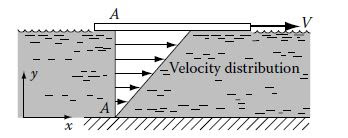Types of flow and how to characterize them:
- Closed-conduit
flows: Type of flow that is completely enclosed by
restraining solid surfaces. Examples include flow through a pipe.
- Open-channel flows:
In
this flow type there is one surface exposed to atmospheric pressure. Examples include
flow in a river and flow in a spillway.
- Unbounded flows: In
this flow the fluid is not in contact with any solid surface. Examples are the
jet that issues from a tap and the jet from a can of spray paint.
KINEMATICS OF FLOW
In fluid flow situations
velocity often needs to be determined. However, velocity generally varies in
the flow field. The flow can thus be classified according to how the velocity
varies.
One-dimensional
flow occurs if the parameters of both the fluid and the
flow are constant at any cross section normal to the flow. It can also occur
when represented by average values over the cross section. Although the flow
velocity can change from point to point it remains constant at each location.
The figure below
illustrates velocity distributions for a one-dimensional flow:
Two-dimensional
flow occurs when the fluid or flow parameters have a
gradient in two directions. For flow in a pipe, the velocity at any cross
section is parabolic thus the velocity is a function of the radial coordinate.
Additionally, a pressure gradient exists in the axial direction that maintains
the flow i.e., a pressure difference between inlet and outlet that causes the
fluid to flow. Even though the fluid flows in one direction, due to the
pressure and velocity gradient, the flow is classified as two-dimensional. This
is illustrated as follows:
Another example of
two-dimensional flow occurs when at the constant area section velocity is a
function of one variable but at the convergent section, velocity is a function
of two space variables. Furthermore, a pressure gradient exists that maintain
the flow. This is illustrated as follows:
Another example of a one-directional, two-dimensional flow where gradients exist in two dimensions is illustrated below:
Three-dimensional flow occurs when the fluid velocity or flow parameters vary with respect to all three space variables. Thus, a gradient exists in three directions.
Steady Flow occurs
when conditions do not vary with time or when fluctuating variations are small
with respect to mean flow values, and the mean flow values do not vary with
time.
Unsteady Flow
occurs when flow conditions change with time.
Quasi-steady Flow
occurs in some unsteady flows, where it is permissible or even necessary to
assume that steady flow exists to obtain a solution.







